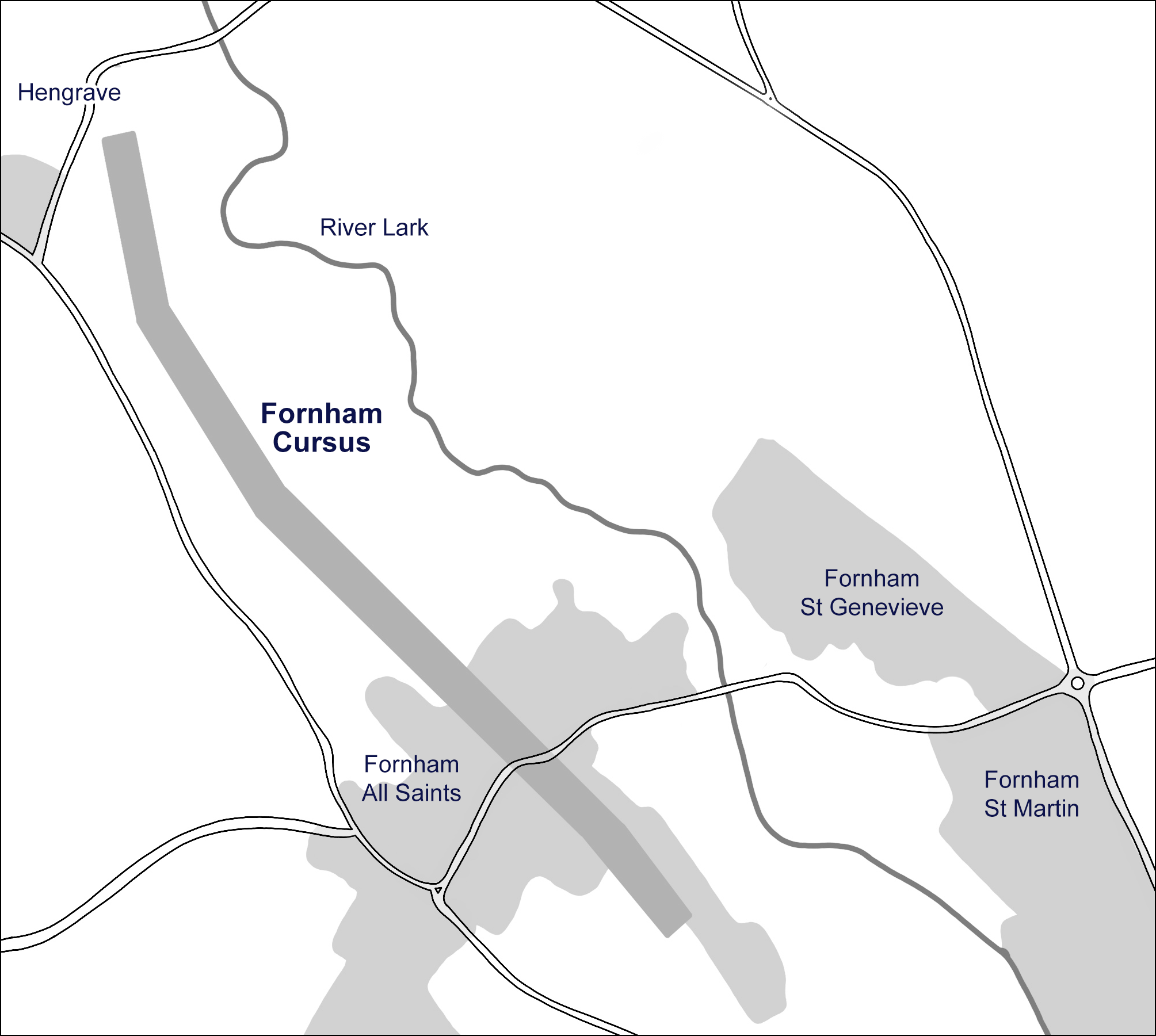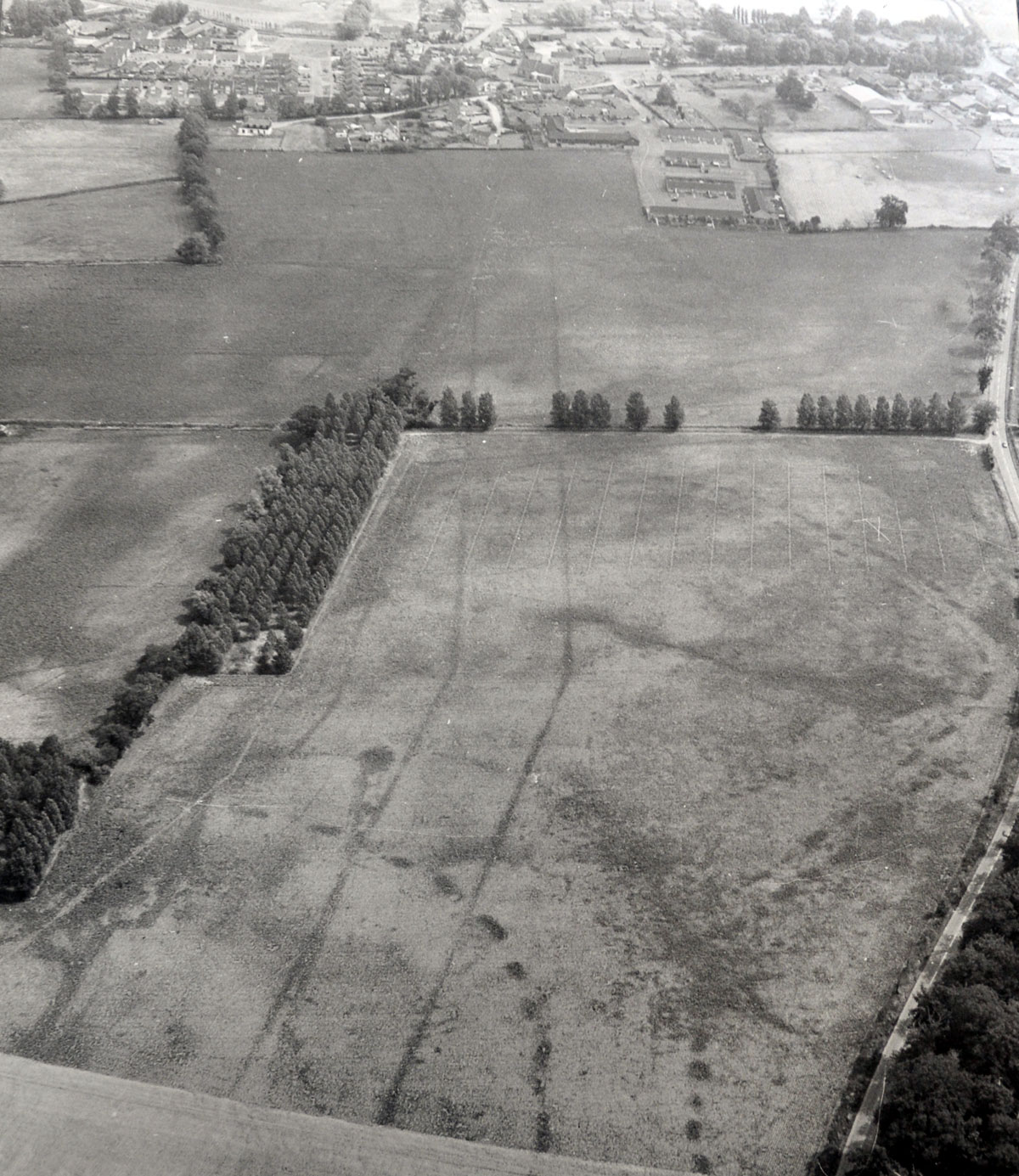Fornham Cursus

The Fornham Cursus is thought to have been constructed over 5,000 years ago, between 3,400 – 3,000 B.C. A Cursus is constructed out of two parallel linear ditches with internal banks, that are closed off at the ends creating an elongated rectangle enclosure. There are around 200 examples known across the British Isles.
Situated in the Lark valley, just to the north-east of Bury St. Edmunds, it is one of only two in the whole of Suffolk and is an impressive 1.87km long, running from Hengrave through Fornham village, ending in a field beside Pigeon Lane and averaging 40 metres in width. Crop marks indicate where timber palisades might have stood at the end of the double ditched enclosure of the cursus itself and it is this feature which has been referred to as the ‘Bury henge’. There are four circular ring ditches, some horseshoe shaped, and others indicating a possible mound in the centre and measuring up to 165 feet across are positioned exactly where the Fornham Cursus terminates.

Edward Martin, who first brought these structures to light refers to them as ‘hengiform’ monuments [1] as traditionally the average henge diameter is usually over 200ft across. [2] Similar henge monuments are only known to occur in association with cursus in six other cases and with smaller hengiform monuments in another two. [3] Some feel it is possible that the Fornham Cursus would have extended even longer than its present accepted length, possibly reaching the Abbey at Bury St. Edmunds, making it nearly twice its 1.87 km length. The Greater Stonehenge Cursus is not that much ‘greater’, running for 2.74 km across the chalk downs north of Stonehenge. [4] It has been estimated that for a typical long barrow 7000 human hours of intensive construction would have been required, [5] whereas for a cursus several kilometres long, it could have been twenty times this.
The name ‘cursus’ derives from the 18th century antiquarian William Stukeley’s idea that they were ‘prehistoric racetracks’. [6] A cursus has often been thought to be connected with some kind of mortuary function, though clear evidence for their intended use continues to elude us to this day. They do however often occur in wider ritual landscapes and close by other funerary monuments, enhancing their sacred and ceremonial nature, although these other monuments may of course have been added later. [7]
Like with long barrows, a cursus offered a means of directing the gaze down its length towards a focal point, usually the sun, a rising or setting star. The Fornham Cursus, as with the Dorset Cursus, is in three distinct sections, each with its own orientation with each section perhaps designed to align to its own particular astronomical rising or setting. For instance, the earlier section of the Dorset Cursus points straight at the midwinter solstice sunset, just as the Stonehenge Cursus is directed towards the equinoctial sunrise. [8]
Astronomical phenomena in relation to landscape monuments contributed to a perceived unity between the land and the sky, both past and present contributing to the way in which space was experienced. In turn, ritual sites and monuments reinforced and became expressions of cosmological ideas designed to promote the impression that the landscape stood at an axial point of an integrated cosmos. [9]
Cursus, along with megalithic stone rows have been considered to be monuments designed in the form of monumental snakes symbolising both the Earths and mans (and womens) inner energy patterns. [10] This serpentine archetype is representative of the naked goddess in her serpent form and is indicative of Neolithic Mother Goddess iconography of the time. [11]
References
- Martin, E.A. (1982) When is a Henge Not a Henge?, in Suffolk Institute of Archaeology and History, Vol. 35. Part 2.
- Burl, A. (1979) Prehistoric Avebury, Yale University.
- Burl, A. (1979) Ibid.
- Startin, W in North, J. (1996) Stonehenge: Neolithic Man and the Cosmos, Harper Collins.
- Startin, W in North, J. (1996) Ibid.
- Condit, T. (1995) Avenues for Research, Archaeology Ireland, Vol. 9, No. 4, Issue No. 34, Winter. Published in A County Carlow Cursus or “The Witch’s Slide” – Carlovianna – Carlow Historical and archaeological society, 2003 edition.
- Pennick, N. & Devereux, P. (1989) Lines on the Landscape: Leys and other Linear Enigmas. Robert Hale.
- Startin, W in North, J. (1996) Ibid.
- Thomas, K. (1991) Religion and the Decline of Magic. Penguin.
- Dames, M. (1996) The Avebury Cycle, Thames and Hudson.
- Campbell, J. (1959) Primitive Mythology. New York.
